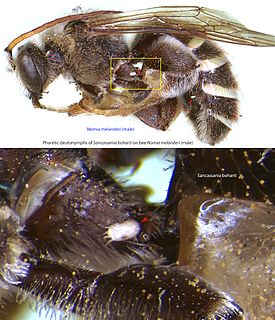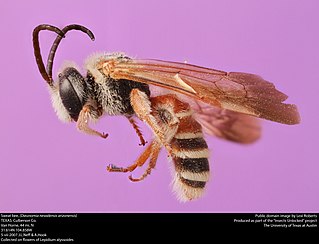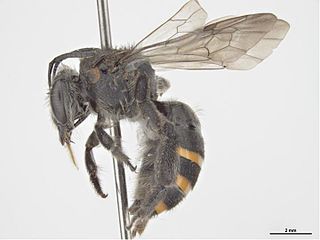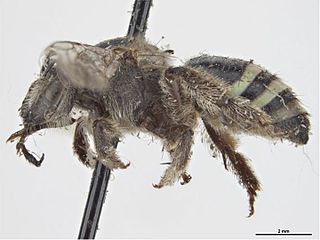
Halictidae is the second-largest family of Anthophila bees. Halictid species occur all over the world and are usually dark-colored and often metallic in appearance. Several species are all or partly green and a few are red; a number of them have yellow markings, especially the males, which commonly have yellow faces, a pattern widespread among the various families of bees. The family is distinguished by the arcuate basal vein found on the wing.
The spiny giant frog or Norton's robber frog, Eleutherodactylus nortoni, is a species of frog in the family Eleutherodactylidae. It is endemic to Hispaniola and known from the Massif de la Hotte, Massif de la Selle, and Sierra de Baoruco, occurring in both the Dominican Republic and Haiti. It is named after James W. Norton who accompanied Albert Schwartz in his 1974 expedition to Hispaniola and collected the holotype.

The alkali bee, Nomia melanderi, is a ground-nesting bee native to deserts and semi-arid desert basins of the western United States. It was described by Theodore Dru Alison Cockerell in 1906.
Lipotriches notiomorpha is a species of bee in the genus Lipotriches, of the family Halictidae. It is endemic to Sri Lanka, where it was first found from Anuradhapura district.
Nomia crassipes is a species of bee in the genus Nomia, in the family Halictidae. It occurs in Southeast Asia.

Nomia is a cosmopolitan genus of sweat bees in the family Halictidae. Many species have opalescent bands on the metasoma. Nomia species are moderate-sized bees that nest in the ground. Most species nest solitarily, but some species also nest communally where females share a nest but where there are no queen or worker castes. Nomia species are found Africa, tropical Asia, Australia, and in North America. There are about 130 species world wide.
Nomia aurata is a species of bee in the genus Nomia, in the family Halictidae.

Nomia tetrazonata, the four-banded nomium, is a species of sweat bee in the family Halictidae. It is found in Central America and North America.

Dieunomia is a genus of sweat bees in the family Halictidae. There are about nine described species in Dieunomia.

Nomiinae is a subfamily of sweat bees in the family Halictidae. There are about 11 genera and at least 550 described species in Nomiinae.

Dieunomia nevadensis, the Nevada nomia, is a species of sweat bee in the family Halictidae. It is found in Central America and North America.
Hylaeus graenicheri, or Graenicher's masked bee, is a species of hymenopteran in the family Colletidae. It is found in North America. The species is one of five in the family Colletidae that are endemic to Florida, and is only found in the southern portion of the state.

Hylaeus hyalinatus, the hyaline spatulate-masked bee, is a species of hymenopteran in the family Colletidae. It is found in North America.

Augochlorella aurata is a species of sweat bee in the family Halictidae. It is found in North America east of the Rocky Mountains. The body is a brilliant green metallic color, diffused to varying extents with a copper, red, or yellow color. Its length is 5 to 7 mm. A common name is golden green sweat bee.

Nomia aurantifer is a species of bee in the genus Nomia, in the family Halictidae. It occurs in Australia and Southeast Asia.

Nomia universitatis is a species of bee in the family Halictidae. It is native to the continental United States.

Nomia lyonsiae is a species of bee in the family Halictidae. It occurs in Australia and Polynesia.

Lasioglossum punctatum is a species of halictid bee found in Indonesia. It was first described in 1858 as Nomia punctata.












